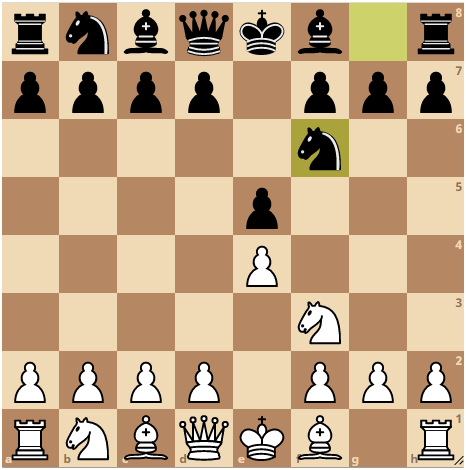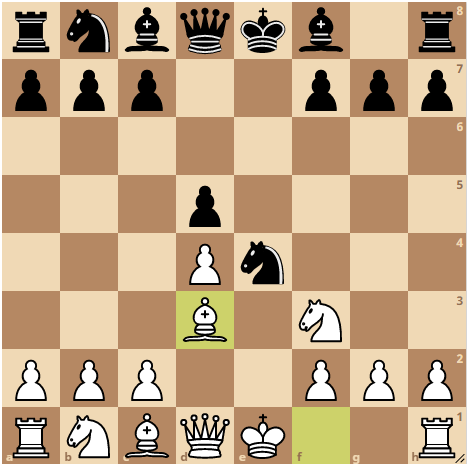The Petrov Defense or the Russian Game is an Opening that allows equal opportunities for both sides to attack by providing a symmetrical game. This Opening was popularized in the mid-19th century and has adopted by many World Champions over the years.
This is a defense played by Black characterised by the opening moves –
- e4 e5
- Nf3 Nf6
The Petrov Defense is also called the Russian Defense or Russian Game and is named after the Russian player Alexander Petrov and was played by many Grandmasters in the past and is played by popular players even today. The opening commonly ends in drawish positions and allows both players equal opportunities to pose strong attacks where a few sharp variations may arise.

General Concept
The opening is a solid and resilient opening where, unlike the conventional NC6 that Black plays on the 2nd move after White’s Nf3, Black responds with Nf6. Instead of defending the e5 pawn, Black counter-attacks White’s e4 pawn. This opening is extremely versatile and can be played by Beginners and Grandmasters. A large credit goes to Super-GM Fabiano Caruana for popularising this opening along with a few other Grandmasters.
Reasons To Play The Petrov Defence
- Nf6 seems to be the most logical move to play as a response to Nf3, to counterattack the e4 pawn.
- Black chooses a more aggressive path instead of playing a defensive game.
- This opening is a great shift away from the conventional Italian Game Opening or the Ruy Lopez Opening and may be off-putting for White in some cases as well.
- The Petrov defense is an easy-to-learn opening with a wide range of theoretical concepts and developments.
- Grandmasters like Kramnik and Anand vicariously played this opening, and a lot of their opponents found it difficult to respond to the Petrov defense.
History
The Opening was popularised in the mid 19th century Alexander Petrov and hence the name. Credit for the early investigations in this opening also go to Carl Jaenisch and therefore is also called the Russian Game in some countries.
Statistics
| RESULT | DATA |
|---|---|
| White Wins | 36.6% |
| Black Wins | 17.9% |
| Draws | 45.5% |
Mainline
- e4 e5
- Nf3 Nf6
- Nxe5
Here Black is forced to play d6 and not Nxe4 immediately due to the following trap.
Trap in Petrov Defense
- e4 e5
- Nf3 Nf6
- Nxe5 Nxe4
- Qe2 Nf6
- Nc6+

Here, White poses a discovered attack on the Black Queen while the White Queen poses a check on the Black King, making White a Queen up.
Mainline
Thus, Black has to play d6 on the 3rd move, and only once White plays Nf3 can Black safely capture the pawn on e4 – Nxe4. White will now try to gain the centre by playing d4, and Black popularly replies with a similar strategy by playing d5. The pawn structure is now completely symmetrical, and White decides to play Bd3 on the 6th move with the idea of playing c4 eventually to reduce the symmetry in the position.
- e4 e5
- Nf3 Nf6
- Nxe5 d6
- Nf3 Nxe4
- d4 d5
- Bd3

This line, also called the Millennium Attack, seems dull to some players and hence alot of players also play Nc3 on the 4th move instead of d4, which is followed by Nxc3 and dxc3, and White accepts the game ahead with doubled pawns on the ‘c’ file. This allows White to open the path for the dark-squared Bishop and also allows the possibility of castling Queenside, using the doubled pawns as a strength. This line may move further with the following moves:
- e4 e5
- Nf3 Nf6
- Nxe5 d6
- Nf3 Nxe4
- Nc3 Nxc3
- dxc3 Be7
- Bf4 Nc6
- Qd2 Be6
- 0-0-0 Qd7
- Kb1

Here, if Black decides to castle Kingside, White can launch multiple attacks using the ‘h’ and ‘g’ file pawns along with the ‘h’ file Rook. In this line, Black should avoid playing Bf6 on the 5th move, which White can follow with Qe2 and Nd5 forcing a pin and winning a piece.
Varitions
1. Steinitz Variation
This variation is also called the Modern Variation of the Petrov Defense which is played to avoid the main symmetrical line. The Steinitz Variation was widely played by Wilhelm Steinitz, where White plays d4 on the third move instead of the conventional Nxe5, which is usually White’s response. Black can now play the obvious – Nxe4 followed by White playing Bd3 as an in-between move. Black can then play d5, and White can play Nxe5, which would lead to the main Petrov line or play dxe5, which would continue into the Steinitz Variation. Black may play Nc5 hoping for a Bishop exchange, but White can avoid this by castling or playing Be2.
- e4 e5
- Nf3 Nf6
- d4 Nxe4
- Bd3 d5
- dxe5 Nc5
- 0-0

If Black plays d6 on the third move instead of capturing the pawn on e4 or d4, the game will transpose into the Philidor Defense.
2. Three Knights Game
Instead of the conventional Nxe5, in this variation, White decides to play Nc3 on the third move. Black’s only option is to play Nc6, and the game transposes into the Four Knights Game.
3. Italian Variation
White’s response to Nf6 with Bc4 on the third move is the Italian Variation of the Petrov Defense, where if Black responds to Bc4 with Nc6, the game transposes into the Two Knights variation of the Italian Game. If Black responds with Nxe4 instead of Nc6, followed by White’s Nc3, this will lead to the Boden–Kieseritzky Gambit. This is not the best option since Black can play multiple other variations. Black can either accept the gambit by playing Nxc3 or transpose it into the Italian Four Knights Game with Nc6.
Step By Step Learning Process
Famous Games
Books to Refer
- Petroff Defence (Everyman Chess) by Alexander Raetsky
- The Petroff – Move by Move by Cyrus Lakdawala
- The Petroff Defence: Current Chess Opening Theory for the Advanced Player by Artur Yusupov
- Chess Openings by Example: Modern Defense by J. Schmidt
Faqs
1. Why play the Petrov Defense?
The Opening is theoretically easy to understand. It can transpose into multiple variations along with the mainline, making it an exciting shift from the contemporary Italian Game or Ruy Lopez Openings that arise after 1.e4 -e5.
Learn Chess. Learn Life Lessons.
Leran Chess from the GrandMasters.
Help your child improve their Strategic Thinking, Critical Thinking, Time Management, etc. through the game of Chess.

This article is technically edited and reviewed by Grand Master Marian Petrov.

CHESS KLUB offers chess classes for kids and adults of all levels. Our coaches include FIDE, National, International and Grand Masters among many.
We offer Online and Classroom coaching.
CHESS KLUB has coaching centers in the US and India now!
More on Petrov Defense
More Chess Openings
Learn Chess from the Masters
Do you want to see your kid excel in Chess?



